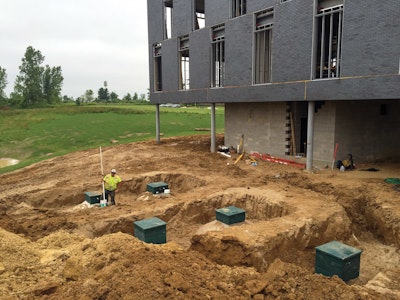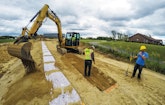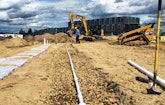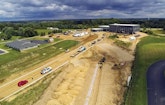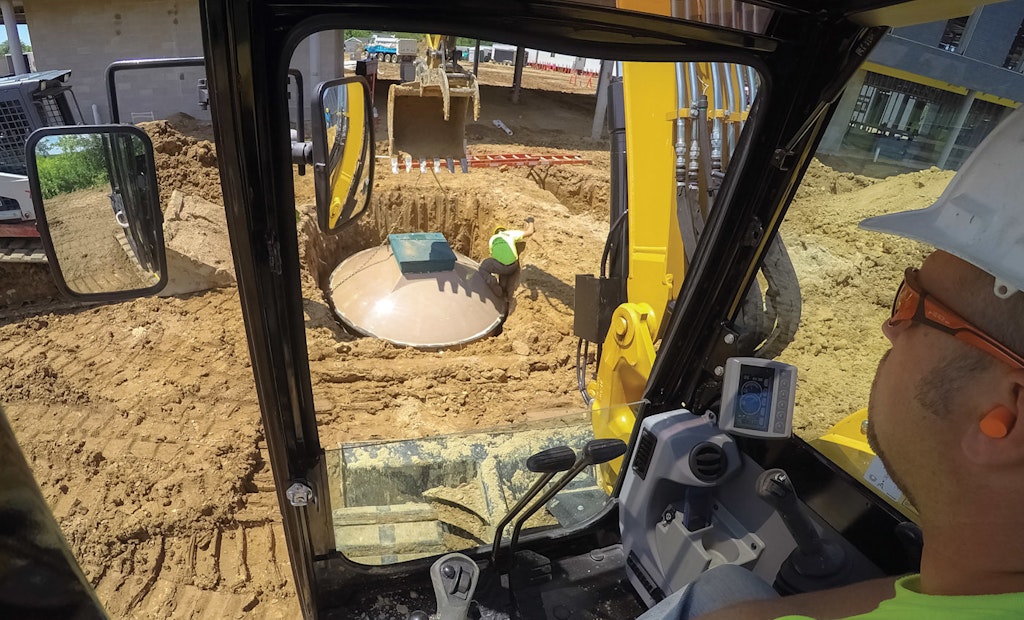Interested in Systems/ATUs?
Get Systems/ATUs articles, news and videos right in your inbox! Sign up now.
Systems/ATUs + Get AlertsHonor Credit Union was building a new operations center in southwestern Michigan about 16 miles from the Indiana border, and the organization had two problems: heavy soils and expensive sewer.
Municipal sewer was only about 1/4 mile away from the site northwest of Berrien Springs, Michigan, but the fee for extending a main that distance and paying monthly charges was cost-prohibitive for the company, says Dervin Witmer of Dig-It Excavating Inc. His company, based in Cassopolis, Michigan, won the contract to install the onsite system that was the eventual solution.
The credit union building is three stories in its tallest part, a single story elsewhere, and at 19,430 square feet the building houses more than 100 people working in marketing, collections, accounting, the customer call center, and other business services. Given the size of the need and the soils, the state of Michigan said only an ATU system would work. The designer chose an Aero-Tech system manufactured not too far away in Plymouth, Indiana.
Aero-Tech units are not complex, Witmer says. The manufacturer does some work in South and Central America, so the units are designed for simplicity of installation and maintenance. Although the up-front cost of the system is expensive, that initial cost plus the cost of continuing maintenance presented a financially attractive solution for the credit union.
Tanks, tanks and more tanks
The system consists of 11 tanks, some to intercept trash, some for dosing, and some for housing the Aero-Tech treatment units. All of the tanks are of fiberglass-spun construction from Aero-Tech.
Effluent pipes emerge from the credit union building at two points. Two 4-inch Schedule 40 lines run to the basement. One line serves one half of the building, including an exercise area and showers, and the other 4-inch line collects wastewater from the other half of the building. Each trash tank is equipped with a Polylok PL-525 effluent filter.
The two drainlines empty into a lift station, a 1,500-gallon tank with duplex N267 Zoeller pumps. The pumps lift wastewater from the level of the basement to the level of the treatment tanks outside. From this point, sloping ground beside the building allows the wastewater to flow through the initial treatment chain by gravity.
Water from the lift station first enters a pair of 1,000-gallon tanks connected in series. These tanks tie into a 1,000-gallon equalization tank and a 2,000-gallon dosing tank for feeding the ATU tanks. These are connected at top and bottom. A 1,000-gallon trash tank for wastewater from the three-story section of the building also ties into the surge and equalization tanks. The 2,000-gallon surge tank houses duplex N57 Zoeller pumps. The pump time-doses dual Aero-Tech AT-1000 ATUs through a distribution box that divides the flow equally.
Effluent from the ATUs flows by gravity into another 1,165-gallon duplex effluent lift station. Here a pair of A.Y. McDonald 404011EF effluent pumps send water 410 feet through a 2-inch line to a 2,000-gallon dosing tank. A pair of Myers WHR7 pumps send water alternately to two sand beds through a 3-inch Schedule 40 pipe.
Each bed is 33 feet wide and 127.5 feet long, and both are set into the slope of a slight hill. To make the beds, Dig-It technicians first stripped off 10 inches of topsoil and built up a 3-foot sand base. They added 6 inches of septic stone and laid 1 1/2-inch pressure line on top of that. Another 6 inches of stone went around and on top of the pipes and was covered with geotextile fabric.
The 3-inch line enters each bed at its center and feeds 54-foot-long sections of the 1 1/4-inch pressure laterals laid to each side of the 3-inch line. Each orifice on the laterals is equipped with a deflector.
There are clean-out caps at the end of every lateral, and technicians put in 4-inch clean-out observation ports at the end of each lateral so they can look at what’s happening inside a bed during maintenance visits.
A total of four NEMA 4-rated SPI control panels at each pump tank operate the system, as well as two control towers for the ATU tanks.
Dig-It technicians used a Cat D5 bulldozer for the heavy work of stripping soil and preparing the site. A Cat 299D multitrack loader and a Cat 308E2 excavator handled the rest of the installation.
Different from the plans
When Dig-It was preparing for the installation, Witmer and his team discovered the piping installed by plumbers did not match the design plans. Those plans called for three 4-inch pipes bringing wastewater out of the building’s upper level. Instead, the plumbers had combined two drainlines inside the building and brought two 4-inch lines out at the basement level and one at grade.
“That totally changed the system. I suggested that a good solution might be shifting the tanks around and using a larger dosing tank. We went back and worked with the designer and the Michigan Department of Environmental Quality. It delayed the job about a month, but we worked it out,” Witmer says.
When the new design was ready, Witmer contacted Aero-Tech, and the company shipped a new tank and a different control panel.
The panel is a simple model without any way to collect performance data that can be loaded into a spreadsheet. Technicians servicing the unit will manually check the controls and floats, and visually inspect the liquid levels in tanks.
Because the sand beds were installed on a slope, the technicians also had to construct a berm to prevent wastewater from flowing out of the bed in the event something plugged or failed. They made the berm out of clay. It was 10 to 12 feet wide and sloped from a height of 2 feet down to grade.
Sand beds were topped with 10 inches of topsoil and planted with a mix of plants native to that area of Michigan.
Plenty of reserve
Because the system has double everything, a problem in one half of the treatment chain will not stop wastewater flows completely. There is also about a day and a half of storage capacity in the surge tank and first dosing tank.
“For us this job was on the large side, and we try to do about one of these every year,” Witmer says.
Anyone considering such larger projects should realize it’s not much different from a residential job.
“The whole design and installation is similar. The only difference is scale. You’re doing more tanks, more controls, and a lot more pipe,” Witmer says. He starts by breaking the project into steps: Where does the flow come in, and what step comes next?
But the real reason he wanted to get into advanced treatment systems is the ongoing maintenance contract.
“We’re pumpers at heart. We’re maintenance guys. We like the ongoing work. We like to troubleshoot. We like to change pumps, all that kind of stuff,” he says.
